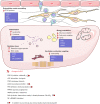Emerging therapies for right ventricular dysfunction and failure
- PMID: 33224787
- PMCID: PMC7666928
- DOI: 10.21037/cdt-20-592
Emerging therapies for right ventricular dysfunction and failure
Abstract
Therapeutic options for right ventricular (RV) dysfunction and failure are strongly limited. Right heart failure (RHF) has been mostly addressed in the context of pulmonary arterial hypertension (PAH), where it is not possible to discern pulmonary vascular- and RV-directed effects of therapeutic approaches. In part, opposing pathomechanisms in RV and pulmonary vasculature, i.e., regarding apoptosis, angiogenesis and proliferation, complicate addressing RHF in PAH. Therapy effective for left heart failure is not applicable to RHF, e.g., inhibition of adrenoceptor signaling and of the renin-angiotensin system had no or only limited success. A number of experimental studies employing animal models for PAH or RV dysfunction or failure have identified beneficial effects of novel pharmacological agents, with most promising results obtained with modulators of metabolism and reactive oxygen species or inflammation, respectively. In addition, established PAH agents, in particular phosphodiesterase-5 inhibitors and soluble guanylate cyclase stimulators, may directly address RV integrity. Promising results are furthermore derived with microRNA (miRNA) and long non-coding RNA (lncRNA) blocking or mimetic strategies, which can target microvascular rarefaction, inflammation, metabolism or fibrotic and hypertrophic remodeling in the dysfunctional RV. Likewise, pre-clinical data demonstrate that cell-based therapies using stem or progenitor cells have beneficial effects on the RV, mainly by improving the microvascular system, however clinical success will largely depend on delivery routes. A particular option for PAH is targeted denervation of the pulmonary vasculature, given the sympathetic overdrive in PAH patients. Finally, acute and durable mechanical circulatory support are available for the right heart, which however has been tested mostly in RHF with concomitant left heart disease. Here, we aim to review current pharmacological, RNA- and cell-based therapeutic options and their potential to directly target the RV and to review available data for pulmonary artery denervation and mechanical circulatory support.
Keywords: Right ventricle; pulmonary arterial hypertension (PAH); remodeling; right heart failure (RHF); right heart failure therapy.
2020 Cardiovascular Diagnosis and Therapy. All rights reserved.
Conflict of interest statement
Conflicts of Interest: All authors have completed the ICMJE uniform disclosure form (available at http://dx.doi.org/10.21037/cdt-20-592). The series “Right Ventricular Dysfunction” was commissioned by the editorial office without any funding or sponsorship. GH served as the unpaid Guest Editor of the series. LCN reports grants and personal fees from Abiomed, grants and personal fees from Cytosorbents, personal fees from Maquet, personal fees from Orion, personal fees from Abbott, personal fees from Zoll, personal fees from Bayer, non-financial support from Edwards, all outside the submitted work. AMKR reports grants from Medical Research Council (UK) and Wellcome Trust (206632/Z/17/Z), research support from Actelion, Novartis, Medtronic, Abbott, and personal fees and research support from SoniVie and Endotronix. SB reports personal fees from Actelion, personal fees from Janssen, personal fees from Allienaire, personal fees from morphic therapeutic, outside the submitted work. The other authors have no other conflicts of interest to declare.
Figures

References
Publication types
Grants and funding
LinkOut - more resources
Full Text Sources
Other Literature Sources
